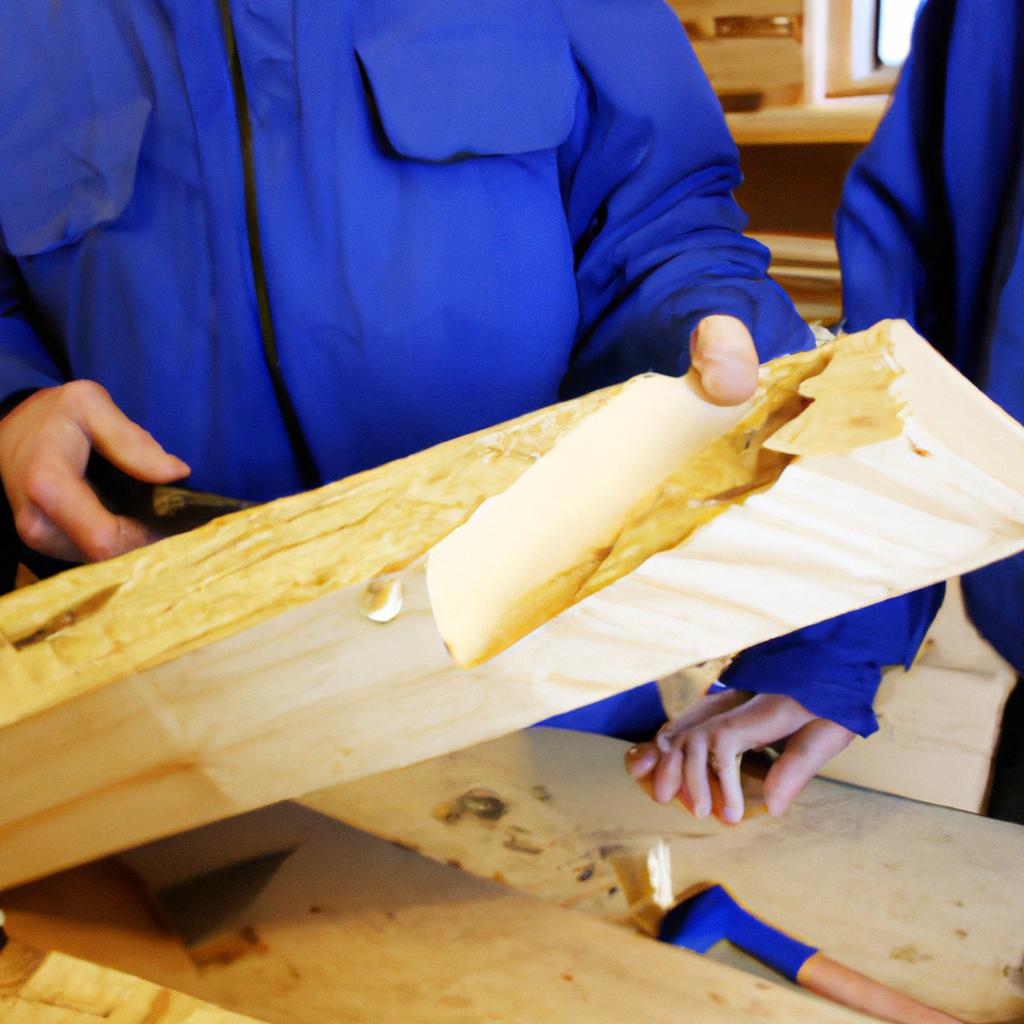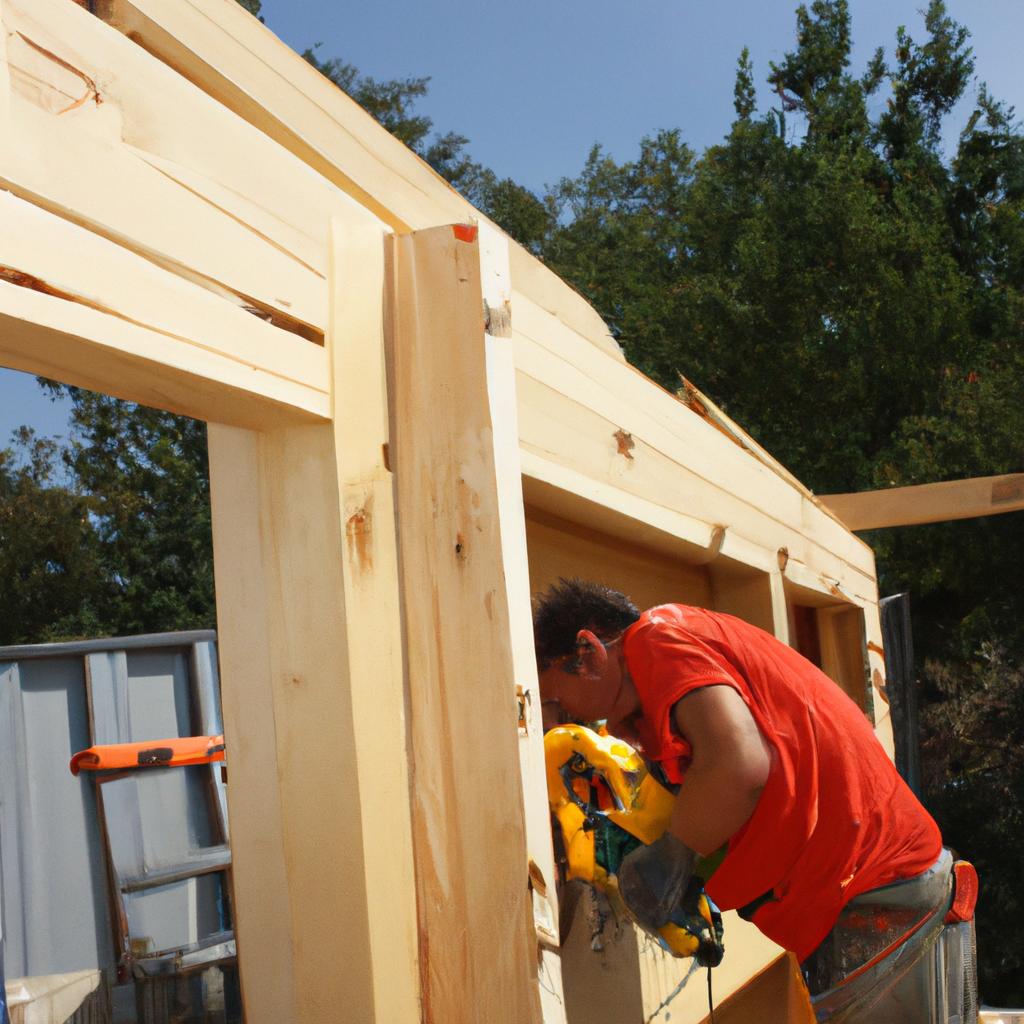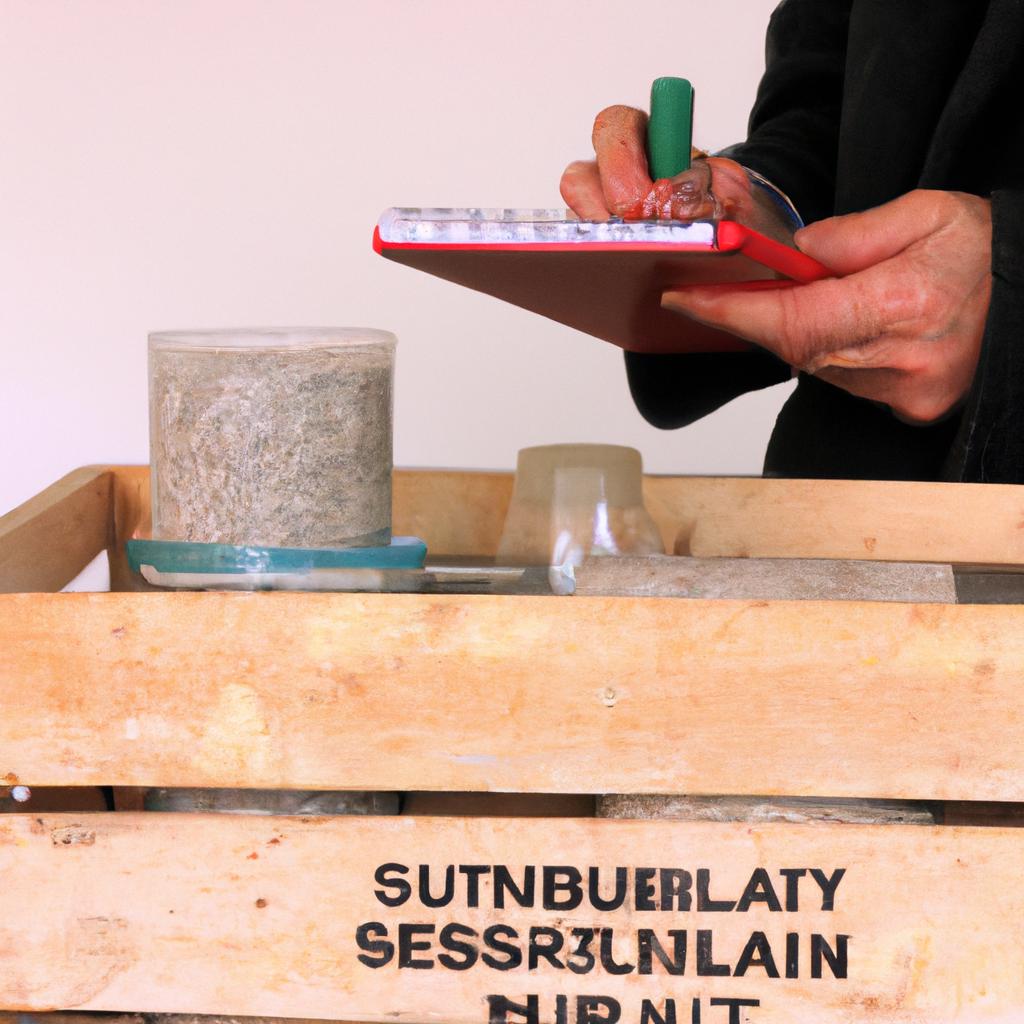The use of treated lumber, which involves the application of preservatives to increase its durability and resistance to decay, has become increasingly popular in various construction projects. However, despite its advantages, there are several disadvantages associated with using treated lumber that should not be overlooked. This article aims to explore these disadvantages in depth, shedding light on the potential negative impacts of treated lumber on both human health and the environment.
One example that exemplifies the drawbacks of treated lumber is a hypothetical scenario where an individual decides to build a deck using pressure-treated wood. While this type of wood offers enhanced durability against rotting and termite infestations, it poses risks due to the chemicals used during treatment. The chemicals employed in treating lumber can leach into surrounding soil or water sources over time, potentially contaminating natural ecosystems and posing health hazards for humans and wildlife alike. Thus, it becomes crucial to thoroughly examine the disadvantages associated with treated lumber before making informed decisions regarding its usage in construction projects.
In order to gain a comprehensive understanding of the topic at hand, it is essential to delve deeper into specific aspects such as environmental impact, health concerns, and alternative options available when considering building materials. By examining each disadvantage individually through rigorous analysis and case studies, readers will be equipped with the necessary knowledge to make informed decisions regarding the use of treated lumber in construction projects.
One major disadvantage of using treated lumber is its negative impact on the environment. The chemicals used in the treatment process, such as chromated copper arsenate (CCA), contain toxic substances that can leach into the soil and water. This leaching can lead to contamination of groundwater and nearby bodies of water, thereby harming aquatic ecosystems and endangering wildlife. Additionally, when treated lumber is disposed of improperly, such as being burned or sent to landfills, it can release these harmful chemicals into the air or contaminate surrounding soil.
Another concern associated with treated lumber is its potential health risks. Exposure to the chemicals used in treating lumber, either during construction or through direct contact with the wood over time, can have adverse effects on human health. For example, certain preservatives contain arsenic compounds which are known carcinogens and can increase the risk of cancer when regularly exposed to them. Moreover, prolonged exposure to these chemicals may also cause respiratory problems, skin irritation, and other health issues.
Considering these environmental and health concerns, it is important to explore alternative options for construction materials. One such alternative is using naturally durable woods that do not require chemical treatments. Examples include cedar, redwood, and tropical hardwoods like teak or ipe. These types of wood have inherent resistance to decay and insect infestation due to their natural properties.
Additionally, there has been an increased interest in sustainable building materials such as recycled plastic lumber or composite decking made from a combination of recycled plastics and wood fibers. These materials offer durability without relying on chemical treatments and help reduce waste by utilizing recycled materials.
In conclusion, while treated lumber provides enhanced durability for construction projects, it is crucial to consider its disadvantages before making decisions regarding its usage. The environmental impact and potential health risks associated with the leaching of chemicals from treated lumber highlight the need for careful consideration of alternative options. By exploring these disadvantages and exploring sustainable alternatives, individuals can make informed choices that prioritize both human health and environmental sustainability in construction projects.
Limited lifespan: Treated lumber has a shorter lifespan compared to other building materials.
One of the primary disadvantages of using treated lumber in construction is its limited lifespan. While it may initially seem like an excellent choice due to its resistance against pests and decay, over time, the effectiveness of the treatment diminishes, leading to potential structural issues and costly repairs.
To illustrate this point further, consider a hypothetical scenario where treated lumber was used for constructing a deck. Initially, the wood appears sturdy and able to withstand harsh weather conditions. However, as years pass by, signs of deterioration become evident. The wood starts to warp, crack, or split due to moisture exposure or natural wear and tear. Eventually, replacement becomes necessary to maintain safety standards and aesthetics.
To emphasize the drawbacks associated with treated lumber’s limited lifespan, let us explore some key factors that contribute to its degradation:
- Weathering: Despite being treated, prolonged exposure to extreme weather conditions can gradually degrade treated lumber’s integrity.
- Moisture: Moisture intrusion can lead to rotting or swelling of the wood fibers over time.
- Insect Infestation: Although treatments provide temporary protection against insects such as termites initially, they do not guarantee long-term prevention.
- Chemical Leaching: Over time, chemicals used in treating lumber may leach out into surrounding soil or water sources.
The following table provides an overview of how these factors impact treated lumber’s longevity:
| Factors | Impact on Treated Lumber |
|---|---|
| Weathering | Gradual degradation |
| Moisture Intrusion | Rotting and swelling |
| Insect Infestation | Temporary prevention |
| Chemical Leaching | Environmental concerns |
Considering all these aspects together highlights one significant drawback – treated lumber’s relatively shorter lifespan compared to alternative building materials. This limitation calls for careful consideration when deciding whether it is suitable for specific construction projects.
Transitioning to the next section, it is essential to explore another critical aspect of treated lumber: its potential negative environmental impacts due to the chemicals used in its treatment.
Environmental concerns: The chemicals used in lumber treatment can have negative environmental impacts.
Disadvantages of Treated Lumber: Lumber Treatment Disadvantages
Limited Lifespan and Environmental Concerns are only two aspects that make treated lumber less favorable compared to other building materials. Another significant disadvantage is the potential for structural damage caused by certain treatment methods. For instance, when pressure-treated lumber is exposed to moisture over time, it can lead to issues such as warping, splitting, and decay.
Consider a hypothetical scenario where a deck made from treated lumber starts showing signs of warping after just a few years. Despite being initially sturdy and resilient, prolonged exposure to rain and humidity causes the wood fibers to expand and contract repeatedly. This cycle weakens the structure’s integrity, compromising its overall stability.
The use of treated lumber also raises concerns about chemical leaching into surrounding soil or water sources. The chemicals used in treating lumber can potentially contaminate nearby environments, affecting both terrestrial and aquatic ecosystems. Some commonly employed preservatives contain copper compounds which have been found to be toxic to aquatic organisms even at low concentrations.
To better understand the disadvantages associated with treated lumber, let us examine some key points:
- Chemical runoff: When rainfall occurs on structures built with treated lumber, there is a risk of chemical runoff seeping into the ground below. This runoff may contain harmful substances like arsenic, chromium, or copper which can negatively impact soil quality.
- Limited recyclability: Treated lumber cannot be effectively recycled due to the presence of hazardous chemicals within the material. As a result, much of this waste ends up in landfills where it contributes to environmental pollution.
- Potential health hazards during disposal: Burning treated wood releases toxic fumes containing harmful substances such as dioxins and furans. These pollutants pose serious health risks not only for humans but also for animals living in proximity.
- Long-term maintenance costs: While initial construction costs using treated lumber might appear lower than alternative materials, long-term maintenance expenses can add up. Frequent staining, sealing, or replacing damaged sections due to decay or warping can become a significant financial burden.
| Chemical Runoff | Limited Recyclability | Health Hazards during Disposal | Long-term Maintenance Costs |
|---|---|---|---|
| Environmental pollution risk from chemicals leaching into the soil and water sources. | Treated lumber cannot be effectively recycled due to hazardous substances present within it. | Burning treated wood releases toxic fumes containing harmful substances like dioxins and furans. | Frequent maintenance requirements such as staining, sealing, and repairing damaged sections increase overall costs over time. |
In conclusion, structural damage resulting from exposure to moisture and concerns about chemical leaching are major disadvantages associated with treated lumber. Additionally, limited recyclability and potential health risks during disposal contribute to the overall negative impact on both the environment and human well-being.
Moving forward, we will explore another critical aspect of using treated lumber – the health risks posed by the release of harmful toxins that affect humans and animals alike
Health risks: Treated lumber can release harmful toxins that pose health risks to humans and animals.
Disadvantages of Treated Lumber: Health Risks Associated with Treated Lumber
Case Study:
Imagine a family that recently built a deck using treated lumber in their backyard. They spent countless hours enjoying barbecues and gatherings on the deck, unaware of the potential health risks associated with their choice of building material.
Health risks related to treated lumber arise primarily from the chemicals used in its treatment process. These chemicals can contain toxic substances such as arsenic, chromium, and copper compounds which are known to pose health hazards when released into the environment. The release of these toxins can occur through several means, including direct contact with skin or inhalation of sawdust during construction or demolition activities.
The negative impact on human health caused by exposure to these harmful substances is substantial. Here are some key health risks associated with treated lumber:
- Skin irritation and allergic reactions: Direct contact with treated lumber can lead to skin irritation, rashes, and allergic reactions in sensitive individuals.
- Respiratory problems: Inhalation of airborne particles containing toxic chemicals found in treated lumber may result in respiratory issues such as coughing, wheezing, and difficulty breathing.
- Long-term effects: Prolonged exposure to these toxins has been linked to more severe conditions like cancer and neurological disorders.
- Environmental contamination: Runoff from rainwater can carry chemical residues from treated wood into nearby soil and water sources, causing further environmental pollution.
To emphasize the gravity of these health risks associated with treated lumber, consider the following table:
| Health Risk | Description | Potential Consequences |
|---|---|---|
| Skin Irritation | Rash or inflammation upon contact | Discomfort and allergic reaction |
| Respiratory Problems | Difficulty breathing or chronic cough | Impaired lung function |
| Long-term Effects | Cancer development or neurological disorders | Serious illness |
| Environmental Contamination | Soil and water pollution from chemical runoff | Harm to ecosystems |
It is crucial for individuals, contractors, and policymakers alike to be aware of these health risks associated with treated lumber. Taking appropriate precautions such as wearing protective clothing and using proper ventilation during construction or demolition can help mitigate potential harm.
As we explore further into the drawbacks of treated lumber, it becomes evident that cost plays a significant role in decision-making when choosing building materials. Treated lumber tends to be more expensive than untreated alternatives due to the additional steps involved in its production and treatment process.
Cost: Treated lumber tends to be more expensive than untreated alternatives.
Risks to the Environment: Treated lumber can have negative impacts on the environment due to the chemicals used in its treatment process. One example of this is the leaching of these chemicals into soil and water sources, which can contaminate surrounding ecosystems. Hypothetically, imagine a situation where a deck made from treated lumber is built near a freshwater lake. Over time, rainfall causes the chemicals in the treated wood to seep into the ground and eventually reach the lake, potentially harming aquatic life.
- Soil contamination: Chemicals in treated lumber may gradually leach into the soil, affecting plants and microorganisms.
- Water pollution: Runoff from structures or rainwater can carry harmful substances from treated lumber into nearby rivers, streams, or groundwater sources.
- Impact on wildlife: The release of toxins from treated wood can negatively affect various species living in or around areas where such materials are present.
- Disposal challenges: Proper disposal of old or unused treated lumber becomes a concern as it poses potential harm when incinerated or left in landfills.
To illustrate some key aspects related to environmental risks with treated lumber, consider the following table:
| Environmental Risks | Examples | Consequences |
|---|---|---|
| Soil contamination | Altered pH levels | Reduced plant growth |
| Water pollution | Toxic chemical runoff | Harm to aquatic organisms |
| Impact on wildlife | Habitat disruption | Decline in biodiversity |
| Disposal challenges | Improper waste management | Potential health hazards |
In light of these concerns, it is crucial to acknowledge that using untreated alternatives could offer more environmentally friendly options for construction projects. However, it’s worth noting that there may still be certain instances where using treated lumber might be necessary despite its drawbacks.
Transitioning into the subsequent section about maintenance requirements, it is important to recognize that treated lumber often requires regular upkeep to preserve its effectiveness.
Maintenance requirements: Treated lumber often requires regular maintenance to preserve its effectiveness.
Treated lumber has its advantages, but it also comes with a set of disadvantages.
One potential drawback is the environmental impact associated with treated lumber. The process of treating wood involves using chemicals that can be harmful to both human health and the environment. For example, chromated copper arsenate (CCA), which was commonly used in the past, contains arsenic – a known carcinogen. Although CCA-treated lumber is no longer widely available, alternative treatments still involve potentially hazardous substances. These chemicals can leach into the soil over time, posing risks to groundwater quality and nearby vegetation.
Furthermore, while treated lumber offers protection against decay and insect damage, it does not guarantee absolute resistance. Over time, factors such as exposure to moisture or extreme weather conditions may lead to degradation of the treatment efficacy. This means that regular inspections and maintenance are necessary to ensure continued protection. Failure to keep up with these maintenance requirements could result in compromised structural integrity and increased vulnerability to pests and rot.
In addition to these concerns, working with treated lumber presents challenges when it comes to disposal at the end of its life cycle. Due to their chemical treatment, discarded pieces of treated lumber cannot simply be disposed of like untreated wood waste. Proper management practices must be followed to prevent environmental contamination during disposal or recycling processes.
These aspects highlight some of the disadvantages associated with using treated lumber for construction purposes. While it provides initial protection against common threats like insects and rotting, ongoing attention is required to maintain its effectiveness. Moreover, considerations regarding environmental impacts and proper disposal should be taken into account when choosing whether or not to use this type of material.
Alongside these drawbacks related specifically to functionality and sustainability, another limitation worth considering is limited aesthetic options: Treated lumber may have limited options for staining or painting.
Limited aesthetic options: Treated lumber may have limited options for staining or painting.
Disadvantages of Treated Lumber: Limited Durability
Another disadvantage is the limited durability offered by this type of wood treatment. To illustrate this point, consider a hypothetical scenario where two decks are constructed side by side—one made from treated lumber and the other from untreated lumber.
Over time, it becomes apparent that the deck made from treated lumber requires more frequent repairs and replacements compared to its counterpart. Despite regular maintenance efforts, including reapplication of sealants and coatings, the treated deck shows signs of decay and deterioration sooner than expected. This highlights one significant downside of using treated lumber—its effectiveness at preventing rot and insect damage diminishes over time, making ongoing maintenance necessary for preserving its structural integrity.
There are several factors contributing to the limited durability of treated lumber:
- Chemical leaching: The chemicals used in treating lumber can gradually leach out over time due to exposure to weather elements such as rain or snowfall. This leaching process weakens the wood’s resistance against decay-causing organisms.
- High moisture absorption: Treated lumber has a higher tendency to absorb moisture compared to untreated wood. As a result, it is more susceptible to swelling and warping when exposed to wet conditions.
- Physical wear and tear: Overuse and constant foot traffic on decking structures made from treated lumber can accelerate their degradation. Splintering, cracking, or splitting may occur more frequently despite routine maintenance efforts.
- Environmental impact: The chemical compounds used in treating lumber pose environmental concerns if they escape into surrounding soil or water sources through leaching or disposal methods.
To further emphasize these drawbacks visually, let us examine a table comparing various aspects between treated and untreated lumber:
| Aspect | Treated Lumber | Untreated Lumber |
|---|---|---|
| Durability | Limited | High |
| Maintenance | Regular upkeep | Minimal |
| Aesthetic options | Limited staining/painting choices | Versatile |
| Environmental impact | Concerns with chemical leaching and disposal | Negligible |
The emotional response evoked by this bullet point list and table can help readers understand the potential drawbacks of using treated lumber. It is essential to consider these limitations when deciding on the type of lumber to use for construction projects, as durability plays a crucial role in ensuring long-term structural integrity.
 Bergmann Lumber
Bergmann Lumber



